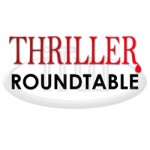

February 18 – 24: “Location, location, location…”
 In real estate they say there are only three important things when buying a house: location, location, location. “Is the location of a novel as relevant?” Join ITW Members Jeffrey J. Mariotte, Jennifer Moss, Heywood Gould, Julia Pomeroy, Linda O. Johnston, Ralph Pezzullo, Lori Armstrong and Robert S. Levinson to find out!
In real estate they say there are only three important things when buying a house: location, location, location. “Is the location of a novel as relevant?” Join ITW Members Jeffrey J. Mariotte, Jennifer Moss, Heywood Gould, Julia Pomeroy, Linda O. Johnston, Ralph Pezzullo, Lori Armstrong and Robert S. Levinson to find out!
~~~~~
 Robert S. Levinson is the bestselling author of nine prior crime-thriller novels. His short stories appear frequently in Ellery Queen and Alfred Hitchcock mystery magazines. He is a Derringer award winner, Shamus award nominee, has won the Ellery Queen Readers Award recognition three times, and is regularly included in “year’s best” anthologies. His nonfiction has appeared in Rolling Stone, Los Angeles Times Magazine, Written By Magazine of the Writers Guild of America-West, Westways, and Los Angeles Magazine. He has served four years on Mystery Writers of America’s (MWA) national board of directors, as well as wrote and produced two MWA annual “Edgar Awards” shows and two International Thriller Writers “Thriller Awards” shows.
Robert S. Levinson is the bestselling author of nine prior crime-thriller novels. His short stories appear frequently in Ellery Queen and Alfred Hitchcock mystery magazines. He is a Derringer award winner, Shamus award nominee, has won the Ellery Queen Readers Award recognition three times, and is regularly included in “year’s best” anthologies. His nonfiction has appeared in Rolling Stone, Los Angeles Times Magazine, Written By Magazine of the Writers Guild of America-West, Westways, and Los Angeles Magazine. He has served four years on Mystery Writers of America’s (MWA) national board of directors, as well as wrote and produced two MWA annual “Edgar Awards” shows and two International Thriller Writers “Thriller Awards” shows.
 Linda O. Johnston’s first published fiction appeared in ELLERY QUEEN’S MYSTERY MAGAZINE and won the Robert L. Fish Memorial Award for Best First Mystery Short Story of the year. Since then, Linda has published more short stories, plus 33 romance and mystery novels, including Harlequin Romantic Suspense as well as the Alpha Force paranormal romance miniseries for Harlequin Nocturne. Linda’s Pet Rescue Mysteries, a spinoff from her Kendra Ballantyne, Pet-Sitter mysteries for Berkley Prime Crime, feature Lauren Vancouver, a determined pet rescuer who runs a no-kill shelter. In this cozy series, “no-kill” refers to pets, not people!
Linda O. Johnston’s first published fiction appeared in ELLERY QUEEN’S MYSTERY MAGAZINE and won the Robert L. Fish Memorial Award for Best First Mystery Short Story of the year. Since then, Linda has published more short stories, plus 33 romance and mystery novels, including Harlequin Romantic Suspense as well as the Alpha Force paranormal romance miniseries for Harlequin Nocturne. Linda’s Pet Rescue Mysteries, a spinoff from her Kendra Ballantyne, Pet-Sitter mysteries for Berkley Prime Crime, feature Lauren Vancouver, a determined pet rescuer who runs a no-kill shelter. In this cozy series, “no-kill” refers to pets, not people!
 Julia Pomeroy was born in Okinawa, and spent her childhood in Benghazi, Mogadiscio, and Rome. At nineteen, she came to the States and worked as an Italian interpreter and an actor, eventually going back to school and graduating from Columbia with a degree in Lit/Writing. Soon after, she and her husband opened and ran a restaurant in Chatham, NY. It wasn’t until they sold it that she finally started to write. Her previous books are THE DARK END OF TOWN, and COLD MOON HOME. She is a member of ITW, SinC, and on the board of MWA-NY. Her talent for the plotting, characterization, pace and impetus required of a classy thriller has been recognized by peers and reviewers alike.
Julia Pomeroy was born in Okinawa, and spent her childhood in Benghazi, Mogadiscio, and Rome. At nineteen, she came to the States and worked as an Italian interpreter and an actor, eventually going back to school and graduating from Columbia with a degree in Lit/Writing. Soon after, she and her husband opened and ran a restaurant in Chatham, NY. It wasn’t until they sold it that she finally started to write. Her previous books are THE DARK END OF TOWN, and COLD MOON HOME. She is a member of ITW, SinC, and on the board of MWA-NY. Her talent for the plotting, characterization, pace and impetus required of a classy thriller has been recognized by peers and reviewers alike.
 Jennifer Moss was born and raised in Evanston, Illinois and is a graduate of Northwestern University. Although she received her degree in music theory/composition, Jennifer had an affinity for computers and entered the technology field upon graduation. In 1996, when the internet was at its infancy, Moss launched one of the first parenting websites, BabyNames.com. She also served as Director of Development and consulted with several Los Angeles internet companies. Jennifer began her writing career as a freelance author for articles about the internet industry in 2000. Her first book, THE ONE-IN-A-MILLION BABY NAME BOOK was published in 2008 by Perigee Press (a division of Penguin) as a companion to her website.
Jennifer Moss was born and raised in Evanston, Illinois and is a graduate of Northwestern University. Although she received her degree in music theory/composition, Jennifer had an affinity for computers and entered the technology field upon graduation. In 1996, when the internet was at its infancy, Moss launched one of the first parenting websites, BabyNames.com. She also served as Director of Development and consulted with several Los Angeles internet companies. Jennifer began her writing career as a freelance author for articles about the internet industry in 2000. Her first book, THE ONE-IN-A-MILLION BABY NAME BOOK was published in 2008 by Perigee Press (a division of Penguin) as a companion to her website.
 Jeffrey J. Mariotte is the award-winning author of more than fifty books, including original supernatural thrillers Season of the Wolf, Cold Black Hearts, River Runs Red and Missing White Girl, horror epic The Slab, thriller The Devil’s Bait, teen horror quartet Dark Vengeance, and more, in addition to dozens of comic books and graphic novels. He has worked in many positions in the publishing industry, and is an owner of specialty bookstore Mysterious Galaxy.
Jeffrey J. Mariotte is the award-winning author of more than fifty books, including original supernatural thrillers Season of the Wolf, Cold Black Hearts, River Runs Red and Missing White Girl, horror epic The Slab, thriller The Devil’s Bait, teen horror quartet Dark Vengeance, and more, in addition to dozens of comic books and graphic novels. He has worked in many positions in the publishing industry, and is an owner of specialty bookstore Mysterious Galaxy.
 Heywood Gould got his start as reporter for the NY Post. Later he financed years of rejection with the usual colorful jobs – cabdriver, mortician’s assistant, bartender. He is the author of fourteen published books and nine screenplays, including FORT APACHE, THE BRONX, BOYS FROM BRAZIL, COCKTAIL, and ROLLING THUNDER. He has directed four features, ONE GOOD COP, starring Michael Keaton, TRIAL BY JURY with William Hurt, MISTRIAL starring Bill Pullman and DOUBLE BANG with William Baldwin.
Heywood Gould got his start as reporter for the NY Post. Later he financed years of rejection with the usual colorful jobs – cabdriver, mortician’s assistant, bartender. He is the author of fourteen published books and nine screenplays, including FORT APACHE, THE BRONX, BOYS FROM BRAZIL, COCKTAIL, and ROLLING THUNDER. He has directed four features, ONE GOOD COP, starring Michael Keaton, TRIAL BY JURY with William Hurt, MISTRIAL starring Bill Pullman and DOUBLE BANG with William Baldwin.
 Ralph Pezzullo is a New York Times bestselling author, and award-winning journalist and playwright, and screenwriter. His books include Jawbreaker, Inside SEAL Team Six, The Walk-In, At the Fall of Somoza, Plunging Into Haiti (winner of the 2006 Douglas Dillon Prize for American Diplomacy), Eve Missing, Blood of My Blood, Most Evil, The Navy SEAL Survival Handbook, the SEAL Team Six thriller Hunt the Wolf, and the upcoming Hunt the Scorpion and (with Don Mann).
Ralph Pezzullo is a New York Times bestselling author, and award-winning journalist and playwright, and screenwriter. His books include Jawbreaker, Inside SEAL Team Six, The Walk-In, At the Fall of Somoza, Plunging Into Haiti (winner of the 2006 Douglas Dillon Prize for American Diplomacy), Eve Missing, Blood of My Blood, Most Evil, The Navy SEAL Survival Handbook, the SEAL Team Six thriller Hunt the Wolf, and the upcoming Hunt the Scorpion and (with Don Mann).
 Lori Armstrong left the firearms industry in 2000. Her 1st book, BLOOD TIES was nominated for a 2005 Shamus Award. HALLOWED GROUND received a 2006 Shamus Award nomination, and won the 2007 WILLA Cather Literary Award. SHALLOW GRAVE was nominated for a 2008 High Plains Book Award and finalLed in the WILLA Cather Literary Award. SNOW BLIND won the 2008 Shamus Award. The 1st book in the Mercy Gunderson series, NO MERCY won the 2010 Shamus Award for Best Hardcover Novel and finalled for the WILLA Cather Literary Award. MERCY KILL released in Jan. 2011. MERCILESS released in Jan. 2013. Lori lives in western South Dakota.
Lori Armstrong left the firearms industry in 2000. Her 1st book, BLOOD TIES was nominated for a 2005 Shamus Award. HALLOWED GROUND received a 2006 Shamus Award nomination, and won the 2007 WILLA Cather Literary Award. SHALLOW GRAVE was nominated for a 2008 High Plains Book Award and finalLed in the WILLA Cather Literary Award. SNOW BLIND won the 2008 Shamus Award. The 1st book in the Mercy Gunderson series, NO MERCY won the 2010 Shamus Award for Best Hardcover Novel and finalled for the WILLA Cather Literary Award. MERCY KILL released in Jan. 2011. MERCILESS released in Jan. 2013. Lori lives in western South Dakota.
- LAST GIRL MISSING with K.L. Murphy - July 25, 2024
- CHILD OF DUST with Yigal Zur - July 25, 2024
- THE RAVENWOOD CONSPIRACY with Michael Siverling - July 19, 2024
